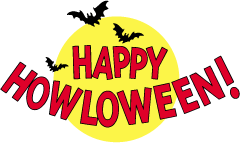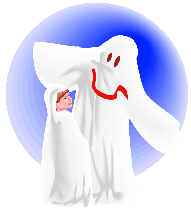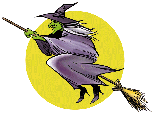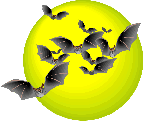

Happy Samhain (pronounced sow-ain),
 The final day of October, Halloween or All Hallow's Eve, and lesser
known as November Eve or Samhain's Eve, is probably the most famous
ritualistic holiday from our pagan past. You see, 'All Hallows'
refers to Samhain (or Samhuinn), November 1st, that marks the
beginning of winter, at which time it was customary to slaughter
livestock. It is the first day of the month ruled by the goddess
Samhain, the Irish name for the month of November. Its eve marked
the end of the old year in the Celtic calendar, and its dawn the
beginning of the new year. Samhain is thus a time between the
years and between the worlds, when the veil between the present
and the past, the living and the dead, is thinner than usual.
It is the Festival of the Dead, that time of year when we remember
our ancestors and hail our descendants. It was also a feast of
fairies who ruled the festival but left after it was over and
remained away until Beltane; it was a dangerous time for mortals
as fairies could 'take' them. In the Christian tradition, November
1st celebrates all of the departed saints, while November 2nd
remembers the souls of all the dead not elevated to sainthood
(that's you and me folks). Materially, the nature of the festival,
as with many other celebrations, is the same in the Pagan and
Christian traditions.
The final day of October, Halloween or All Hallow's Eve, and lesser
known as November Eve or Samhain's Eve, is probably the most famous
ritualistic holiday from our pagan past. You see, 'All Hallows'
refers to Samhain (or Samhuinn), November 1st, that marks the
beginning of winter, at which time it was customary to slaughter
livestock. It is the first day of the month ruled by the goddess
Samhain, the Irish name for the month of November. Its eve marked
the end of the old year in the Celtic calendar, and its dawn the
beginning of the new year. Samhain is thus a time between the
years and between the worlds, when the veil between the present
and the past, the living and the dead, is thinner than usual.
It is the Festival of the Dead, that time of year when we remember
our ancestors and hail our descendants. It was also a feast of
fairies who ruled the festival but left after it was over and
remained away until Beltane; it was a dangerous time for mortals
as fairies could 'take' them. In the Christian tradition, November
1st celebrates all of the departed saints, while November 2nd
remembers the souls of all the dead not elevated to sainthood
(that's you and me folks). Materially, the nature of the festival,
as with many other celebrations, is the same in the Pagan and
Christian traditions.
 The festival of Samhain is celebrated widely on its eve. This
is the Christianized festival of All Hallow's Eve, popularly known
as Halloween, which is observed after dark on October 31st. The
paper masks, rubber bats, plastic skeletons, and mock witches'
hats of present-day Halloween parties are a modern expression
of the Pagan festival of remembrance of death and the departed.
In the natural year, Samhain is the third harvest when in the
former days animals were slaughtered and their meat smoked or
salted down for winter. The tangible link with the dead at Samhain
is present in the custom of making divinations on Halloween. Some
Asatru groups remember the dark side of divinity at this festival
in the forms of the dragons Fafnir and Hela, who were goddesses
of the underworld.
The festival of Samhain is celebrated widely on its eve. This
is the Christianized festival of All Hallow's Eve, popularly known
as Halloween, which is observed after dark on October 31st. The
paper masks, rubber bats, plastic skeletons, and mock witches'
hats of present-day Halloween parties are a modern expression
of the Pagan festival of remembrance of death and the departed.
In the natural year, Samhain is the third harvest when in the
former days animals were slaughtered and their meat smoked or
salted down for winter. The tangible link with the dead at Samhain
is present in the custom of making divinations on Halloween. Some
Asatru groups remember the dark side of divinity at this festival
in the forms of the dragons Fafnir and Hela, who were goddesses
of the underworld.
Growth was at its lowest point and cold increasing, so bonfires were lit to encourage the sun by sympathetic magic. As at Beltane bonfires, people jumped over them and cattle were driven through them and witches burned on them. Going through the fire got rid of evil influences but also acted as fumigation to rid the cattle of parasites. Fires of the festival were called 'Samhnagan.'
 Samhain was a time of chaos and the reversal of the normal order,
symbolized by such tricks as blocking up chimneys, leading off
cattle, or throwing cabbage at notable people. The hearth had
to be swept clean and a fire kept burning for the dead. It was
also a season for divination and the reading of omens such as
placing two nuts in the fires as a test for lovers, burning steadily
denoted constancy, popping was for inconstancy: though the rites
varied from one region to another.
Samhain was a time of chaos and the reversal of the normal order,
symbolized by such tricks as blocking up chimneys, leading off
cattle, or throwing cabbage at notable people. The hearth had
to be swept clean and a fire kept burning for the dead. It was
also a season for divination and the reading of omens such as
placing two nuts in the fires as a test for lovers, burning steadily
denoted constancy, popping was for inconstancy: though the rites
varied from one region to another.
Apples and nuts associated with Samhain and Hallowe'en were also connected with the ancient Roman festival of Pomona, on November 1st, a feast of the ripening of fruits and a time when the summer stores were opened up for winter consumption. The apple was the Celtic Silver Bough and the fruit of the otherworld, symbolizing love, fertility, wisdom, and divination; the fruit of heaven and of wise men. The hazel was the sacred tree of Celtic groves and, like all nuts, represented hidden wisdom, lovers, and peace. As the Tree of Life it grew in Avalon by the sacred pool.
 In Ireland, Samhain, as Oiche Shamhna, was celebrated everywhere;
it was also, later, Hallowtide or Hallowe'en, the Pagan and Christian
becoming indistinguishable. Again, ghosts and fairies were both
active. Food offerings were to be left for both and it was dangerous
to travel at night for fear of being led astray by fairies; iron
or steel could be carried as apotropaic. After the advent of Christianity
'parshell' crosses were made and fixed to house, byre, and stable
doors. Bonfires were lit as the 'Samhain pile' and ashes and burning
brands were thrown out. There were also parties of 'guisers' going
about collecting apples, nuts, or money and the hobby-horse, or
horse's head, figured in the ceremonies. The evil powers were
the Formorians and in earlier times human sacrifices; this was
not only to propitiate the bowers but also to bring fertility.
In Ireland, Samhain, as Oiche Shamhna, was celebrated everywhere;
it was also, later, Hallowtide or Hallowe'en, the Pagan and Christian
becoming indistinguishable. Again, ghosts and fairies were both
active. Food offerings were to be left for both and it was dangerous
to travel at night for fear of being led astray by fairies; iron
or steel could be carried as apotropaic. After the advent of Christianity
'parshell' crosses were made and fixed to house, byre, and stable
doors. Bonfires were lit as the 'Samhain pile' and ashes and burning
brands were thrown out. There were also parties of 'guisers' going
about collecting apples, nuts, or money and the hobby-horse, or
horse's head, figured in the ceremonies. The evil powers were
the Formorians and in earlier times human sacrifices; this was
not only to propitiate the bowers but also to bring fertility.
In ancient Pagan Ireland, Samhain Day itself, La Samhna, was the middle day of a week's celebration at which the high king would receive representatives of his nation bearing examples of their arts and crafts. This holy week of Samhain has given rise to a number of festival around early November. The celebration of Guy Fawkes Night, when an effigy of a seventeenth-century would-be regicide is burned, is also directly related to the older fire festival. The central focus of Guy Fawkes night is the bon fire, continuing the practice of incinerating effigies that represent the ills and sadness of the year just passed. In Britain, Remembrance Day, November 11th, commemorates the fallen of World War I and is also related to the earlier Celtic festival of the dead. It is held on the festival of the Martinmas, otherwise known Old November Day. The traditional sigil for the festival of Samhain is a knot of protection.
 Traces of human sacrifice are also seen in the Welsh 'Black Sow'
ceremony in which everyone ran downhill as fast as possible shouting
'the Black Sow take the hindermost,' the last person being the
victim. The Black Sow was the spirit of evil, cold, and death.
The same significance applied to the victim chosen by the carline
cake at Beltane. The wholesale killing of animals was not only
for winter food but because there was not enough feed for them
in the fields in winter. The slaughter took on a ritual and sacrificial
aspect among the Celts and Teutons and bore the marks of an earlier
pastoral festival with the emphasis on semi-divine animals. Feasting
followed and the dead were also feasted. In Germany and Gaul,
boisterous processions took place and men dressed in animal masks
and skins, thus gaining contact with the sacred animals and with
the deities.
Traces of human sacrifice are also seen in the Welsh 'Black Sow'
ceremony in which everyone ran downhill as fast as possible shouting
'the Black Sow take the hindermost,' the last person being the
victim. The Black Sow was the spirit of evil, cold, and death.
The same significance applied to the victim chosen by the carline
cake at Beltane. The wholesale killing of animals was not only
for winter food but because there was not enough feed for them
in the fields in winter. The slaughter took on a ritual and sacrificial
aspect among the Celts and Teutons and bore the marks of an earlier
pastoral festival with the emphasis on semi-divine animals. Feasting
followed and the dead were also feasted. In Germany and Gaul,
boisterous processions took place and men dressed in animal masks
and skins, thus gaining contact with the sacred animals and with
the deities.
At Samhain, a sheaf of corn, a branch of evergreen or mistletoe, symbolically carried on the dying powers of vegetation. Carrying or decorating with evergreens demonstrates that life as not died. Pliny gives an account of a Druid festival of the cutting of the mistletoe from an oak tree: it was cut with a 'golden' sickle and caught in a white cloak, as it much never touch the ground. Two white bulls were sacrificed and a feast held. Samhain was also a time of truce with no fighting, violence, or divorce allowed, hence it was a time of marriage. Accounts were closed, debts collected, contracts made, and servants hired.
Recent news stories report that "The Farmers Almanac" is lobbying to set Halloween as the last Saturday in October, so that parents will be able to participate with their children, without having to worry about getting up for work in the morning.
Until that "Giving of Thanks" day,

Note: This is an excerpt of a pending book entitled "The Hidden History of Holidays." If you would like to be notified when it becomes available fill out the form below.
This book is being written one holiday at a time:
Other book projects include Mystery of America and Secrets We Live By (Pending).
Tédd is an author, lecturer, researcher, videographer, and amongst other interests is writing several books on a variety of topics.